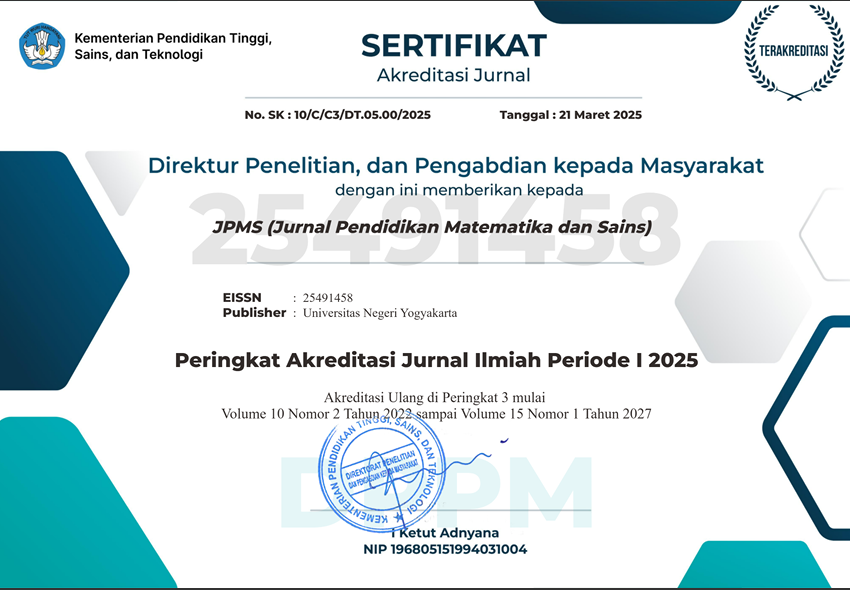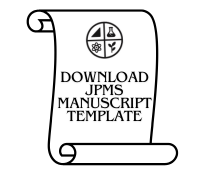Mengapa Media Berbasis Komputer dalam Pembelajaran Matematika Penting? Perspektif Guru dan Siswa
DOI:
https://doi.org/10.21831/jpms.v6i2.23958Keywords:
media berbasis komputer, media pembelajaran, pembelajaran matematikaAbstract
Abstrak
Dewasa ini pemanfaatan teknologi telah merambah semua aspek kehidupan, termasuk dalam pendidikan. Salah satu contoh pemanfaatan teknologi dalam pendidikan yaitu penggunaan media berbasis komputer dalam proses pembelajaran. Studi ini bertujuan untuk mendeskripsikan perspektif guru dan siswa tentang pentingnya media berbasis komputer dalam pembelajaran matematika. Studi ini menggunakan pendekatan kualitatif dengan jenis penelitian fenomenologi. Partisipan penelitian terdiri dari 6 guru matematika dan 227 siswa yang berasal dari SMP, SMA, dan SMK di Provinsi Bengkulu dan Daerah Istimewa Yogyakarta. Pengumpulan data dilakukan menggunakan angket guru dan angket siswa. Analisis data dilakukan menggunakan model analisis kualitatif yang dikembangkan oleh Bogdan & Biklen. Hasil penelitian menunjukkan bahwa: (1) menurut perspektif guru pembelajaran matematika dengan media pembelajaran berbasis komputer penting dilakukan; (2) sarana dan prasarana sekolah serta kompetensi guru untuk menunjang pembelajaran berbasis komputer sudah cukup memadai; (3) guru sangat tertarik untuk menerapkan pembelajaran matematika menggunakan media berbasis komputer yang interaktif dan menarik; (4) siswa lebih tertarik dengan media pembelajaran berbasis komputer dari pada menggunakan buku pelajaran; (5) terdapat berbagai potensi yang bersumber dari siswa yang dapat mendukung pemanfaatan komputer sebagai sumber belajar siswa, seperti kepemilikian komputer/laptop, kemampuan mengoperasikan komputer/laptop, terbiasa menggunakan komputer/laptop sebagai sumber belajar, dan durasi penggunaan komputer dalam aktivitas sehari-hari cukup tinggi.
Kata Kunci: media berbasis komputer, media pembelajaran, pembelajaran matematika
Why Computer-Based Media in Mathematics Learning is Important?
A Teachers' and Students' Perspective
Abstract
Today the use of technology has penetrated all aspects of life, including in education. One example of the use of technology in education is the use of computer-based media in the learning process. This study aims to describe the perspectives of teachers and students about the importance of computer-based media in mathematics learning. This study uses a qualitative approach, spesifically phenomenological research type. The research participants consisted of 6 mathematics teachers and 227 students from Junior and Senior High school, and Vocational Schools in Bengkulu and Special Region of Yogyakarta Province. Data collection was carried out using teacher questionnaire and student questionnaire. Data analysis was performed using a qualitative analysis model developed by Bogdan & Biklen. The results of the study show that: (1) according to the teachers' perspective, mathematics learning with computer-based learning media is important to do; (2) schools' facilities and and teachers' competencies to support computer-based learning is sufficient; (3) teachers are very interested in applying mathematics learning using interactive and interesting computer-based media; (4) students are more interested in computer-based learning media than using textbooks; (5) there are various potentials that come from students that can support the use of computers as a learning resource of students, such as the ownership of computers/laptops, the ability to operate computers/laptops, students are accustomed to using computers/laptops as learning resources, and the duration of computer usage in daily activities is quite high.
Keywords: computer based media, mathematics learning, learning media
References
Apino, E., & Retnawati, H. (2017). Developing mathematical higher order thinking skills of senior high school students. Journal of Phisycs: Conference Series, 812, 1-7. doi:10.1088/1742-6596/812/1/012100
Asosiasi Penyelenggara Jasa Internet Indonesia [APJII]. (2017). Infografis penetrasi dan prilaku pengguna internet indonesia. Retrieved from https://apjii.or.id/survei2017
Bogdan, R., & Biklen, S. K. (1997). Qualitative research for education. Boston, MA: Allyn & Bacon.
Chandrawati, S. R. (2010). Pemanfaatan e-learning dalam pembelajaran. Jurnal Cakrawala Kependidikan, 8(2), 101–203.
Galbraith, P., & Haines, C. (1998). Disentangling the nexus: Attitudes to mathematics and technology in a computer learning environment. Educational Studies in Mathematics, 36(3), 275–290.
Ganguli, A. B. (1990). The microcomputer as a demonstration tool for instruction in mathematics. Journal for Research in Mathematics Education, 21(2), 154–159.
Ganguli, A. B. (1992). The effect on students' attitudes of the computer as a teaching aid. Educational Studies in Mathematics, 23(6), 611–618.
Hoskins, S. L., & van Hooff, J. C. (2005). Motivation and ability: Which students use online learning and what influence does it have on their achievement? British Journal of Educational Technology, 36(2), 177-192
Kratochvil, J. (2013). Evaluation of e-learning course, information literacy, for medical students. The Electronic Library, 31(1), 55-69.
Kozma, R. B. (1991). Learning with media. Review of Educational Research, 61(2), 179-212.
Lagrange, J., & Kynigos, C. (2014). Digital technologies to teach and learn mathematics : Context and re-contextualization. Educational Studies in Mathematics, 85(3), 381-403. doi:10.1007/s10649-013-9525-z
Lazarides, R., & Ittel, A. (2012). Mathematics interest and achievement: What role do perceived parent and teacher support play? A longitudinal analysis. International Journal of Gender, Science, and Technology, 5(3), 207-231.
Lin, M. H., Chen, H. C., & Liu, K. S. (2017). A study of the effects of digital learning on learning motivation and learning outcome. EURASIA Journal of Mathematics Science and Technlology Education, 13(7), 3553-3564. doi:10.12973/eurasia.2017.00744a
Mitchell & Savill-Smith, 2004;
NCTM. (2000). Principles and standards for school mathematics. Reston, VA: Author.
Puspendik. (2015). Laporan hasil UN tahun pelajaran 2014/2015 SMP, SMA, dan SMK. Jakarta: Kemendikbud.
Puspendik. (2016). Laporan hasil UN tahun pelajaran 2015/2016 SMP, SMA, dan SMK. Jakarta: Kemendikbud.
Puspendik. (2017). Laporan hasil UN tahun pelajaran 2016/2017 SMP, SMA, dan SMK. Jakarta: Kemendikbud.
Puspendik. (2018). Laporan hasil UN tahun pelajaran 2017/2018 SMP, SMA, dan SMK. Jakarta: Kemendikbud.
Rackov, G. (2011). Application of computers in initial teaching of mathematics. Methodological Horizons, 6(1), 105-117.
Retnawati, H., Hadi, S., Nugraha, A. C., Arlinwibowo, J., Sulistyaningsih, E., Djidu, H., ... Iryanti, H. D. (2017). Implementing the computer-based national examination in indonesian schools: the challenges and strategies. Problems of Education in the 21st Century, 75(6), 612-633.
Roza, Y., Yuanita, P., Saragih, S., & Alfajri, H. (2017). Development of computer-based media for mathematics learning at secondary schools on the topic of lines , angles and rectangular. Proceedings of 4th International Conference of Research in Education on Mathematics and Science (ICRIEMS), Yogyakarta.
Sarmah, H. K., & Hazarika, B. B. (2012). An analysis of student's interest in mathematics in relation to gender of students and type of school. International Journal of Mathematics Research, 4(6), 707-725.
Simonson & Thompson, 1997
Sirait, E. D. (2016). Pengaruh minat belajar terhadap prestasi belajar matematika. Jurnal Formatif, 6(1), 35-43.
Stosic, L. (2015). The importance of educational technology in teaching. International Journal of Cognitive Research in Science, Enginering and Education. 3(1), 111-114
Sumardyono. (2004). Karakteristik matematika dan implementasinya terhadap pembelajaran matematika. Yogyakarta: Depdiknas.
Thomas, M., Tyrrell, J., & Bullock, J. (1996). Using computers in the mathematics classroom: The role of the teacher. Mathematics Education Research Journal, 8(1), 38-57.
Yusuf, M. (2010). Peningkatan hasil belajar matematika siswa melalui lembar kerja siswa (LKS) interaktif berbasis komputer di SMA Muhammadiyah 1 Palembang. Jurnal Pendidikan Matematika, 4(2), 34–44.
Downloads
Published
How to Cite
Issue
Section
Citation Check
License
Jurnal Pendidikan Matematika dan Sains allows readers to read, download, copy, distribute, print, search, or link to its articles' full texts and allows readers to use them for any other lawful purpose. The journal allows the author(s) to hold the copyright without restrictions. Finally, the journal allows the author(s) to retain publishing rights without restrictions
- Authors are allowed to archive their submitted article in an open access repository
- Authors are allowed to archive the final published article in an open access repository with an acknowledgment of its initial publication in this journal

This work is licensed under a Creative Commons Attribution-ShareAlike 4.0 Generic License.





